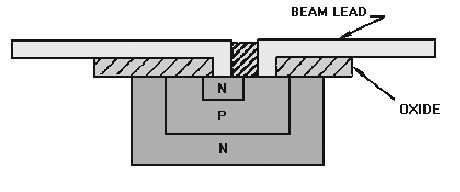1-25
wafer, as shown in figure 1-27. This type of structure imposes no electrical difficulty, and parasitic
capacitance (under 0.05 picofarad per lead) is equivalent to that of a wire-bonded and brazed-chip
assembly. In addition, the electrodes may be tapered to allow for lower inductance, impedance matching,
and better heat conductance. The beam-lead technique is easily accomplished and does not have the
disadvantages of chip brazing and wire bonding. The feasibility of this technique has been demonstrated
in a variety of digital, linear, and thin-film circuits.
Figure 1-27.—Beam-lead technique.
Another advance in packaging is that of increasing the size of DIPs. General purpose DIPs have from
4 to 16 pins. Because of lsi and vlsi, manufacturers are producing DIPs with up to 64 pins. Although size
is increased considerably, all the advantages of the DIP are retained. DIPs are normally designed to a
particular specification set by the user.
Q29. What is the purpose of the IC package?
Q30. What are the three most common types of packages?
Q31. What two methods of manufacture are being used to eliminate bonding wires?
EQUIVALENT CIRCUITS
At the beginning of this topic, we discussed many applications of microelectronics. You should
understand that these applications cover all areas of modern electronics technology. Microelectronic ICs
are produced that can be used in many of these varying circuit applications to satisfy the needs of modern
technology. This section will introduce you to some of these applications and will show you some
EQUIVALENT CIRCUIT comparisons of discrete components and integrated circuits.
J-K FLIP-FLOP AND IC SIZES
Integrated circuits can be produced that combine all the elements of a complete electronic circuit.
This can be done with either a single chip of silicon or a single chip of silicon in combination with film
components. The importance of this new production method in the evolution of microelectronics can be
demonstrated by comparing a conventional J-K flip-flop circuit incorporating solid-state discrete devices
and the same type of circuit employing integrated circuitry. (A J-K flip-flop is a circuit used primarily in
computers.)

